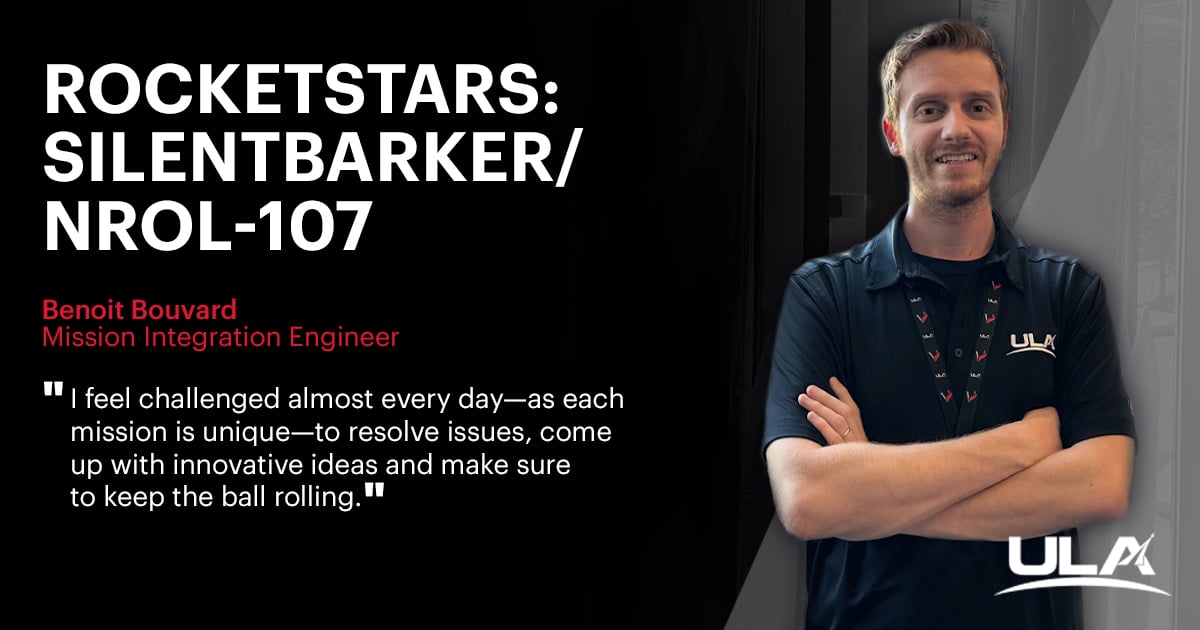
Meet Benoit Bouvard, a former aircraft flight test engineer and now a United Launch Alliance (ULA) avionics mission integrator responsible for ensuring electrical requirements are satisfied to successfully launch the next Atlas V rocket with a national security payload.
Born in a suburb of Paris and now living in Denver, Colorado with his American wife and newborn son, Bouvard has led a circuitous route to reach his self-described “fascinating” job that contributes to putting satellites into space.
“There is something extremely rewarding after a satellite is launched successfully, and a certain sense of pride,” Bouvard said. “ULA is filled with tons of very smart people, and I can say without exaggerating that I feel like I learn something new every day through discussions with people, new projects, issues to resolve on missions, or trainings. Specifically, in my role, I feel like I am getting challenged almost every day, as each mission is unique, to solve issues, come up with innovative ideas and make sure to keep the ball rolling.”
Bouvard has worked tirelessly with the Denver integration teams to prepare for the upcoming SILENTBARKER/NROL-107 launch, planned for Aug. 29 atop an Atlas V 551 rocket from Cape Canaveral Space Force Station, Florida.
“A lot of my job is making sure that electrical interfaces are understood and validated with the customers, making sure we have a clear pathway to verify requirements, bringing forward solutions that minimize technical, schedule and cost risks, organizing the work which means making sure that the teams you work with are aware of what they have to do and when they have to do it, managing priorities between missions, and finally always keeping in mind mission success,” Bouvard explained.
As the avionics integration engineer that has meant working with the different mission stakeholders to validate and verify electrical requirements related to ground interfaces with customer equipment and airborne interfaces with the payload. All those requirements are traced to the Interface Control Document (ICD) and are continuously matured along the pre-launch process.
“I also coordinated the design of the wiring diagram, called the payload servicing schematic, for wire harnesses between ground and airborne interfaces; defined the hardware testing roadmap as well as test requirements; planned and defined ordnance harnesses testing with high current at the Cape; and helped evaluate compatibility between systems, such as providing Ethernet data to ground equipment. I also add the opportunity to work on resolving mission-unique issues such as verifying the correct hardware / software sequencing and channelization for ordnance signal or estimating what is the maximum level of current we can pass through the T-0 umbilical interface, considering hydrogen ignition risks,” Bouvard said.
“The SILENTBARKER/NROL-107 mission is also filled with memories as it is the first mission I handled from beginning to finish. This mission came with a lot of challenges but also with a great team and tons of learning opportunities. It’s also the mission that allowed me to go the Cape for the first time to coordinate harness testing, and I was thrilled to be able to go in the base and visit most of ULA facilities.”
Bouvard began his aerospace career in 2012 at the French company Safran working as an aircraft engine performance analyst, which related to thermodynamics sizing and analysis. He was later promoted to project manager of engine performance on a business jet engine before moving to Texas as a flight test engineer to prepare and monitor tests of the engine.
“The transition from Paris to Texas was a wild one but also fascinating!” Bouvard recalls.
Bouvard joined ULA two years ago.
Growing up in the French town of Les Lilas, Bouvard earned his university degree from IMT Nord Europe in energy engineering, a major focused on designing energy production and transport systems and managing multidisciplinary and international projects. A four-month internship in England at 19 is when Bouvard learned to speak English. “It was a fascinating experience to live in another country at a young age and try to learn a new language day after day in a work setting,” he recalls.
He met his future wife, a native of Boulder, Colorado, while finishing his studies in France “and the rest is history.”
Learn more about the SILENTBARKER/NROL-107 launch
See more photos in our Flickr album

 Back To Blog List
Back To Blog List



